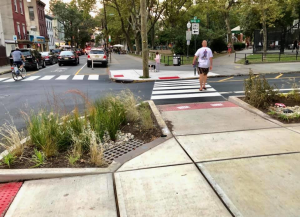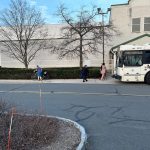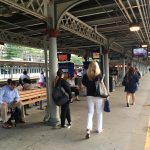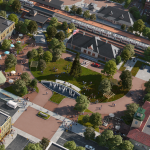New Jersey Future Blog
Amidst rising pedestrian and traffic fatalities, New Jersey seeks to advance safe street design
July 19th, 2022 by Michael Atkins

Photo Credit: City of Hoboken
Street fatalities are on the rise nationally, and right here in New Jersey. The National Highway and Traffic Safety Administration (NHTSA) reports that 2021 marked a 16 year high in roadway fatalities. In New Jersey, our streets and roads claimed 699 lives in 2021, with 220 pedestrian fatalities accounting for approximately 30% of those fatalities. This pace shows no signs of slowing this year: “318 people have been killed on New Jersey’s roadways [as of July 2022], already an 18% increase from last year’s historically high rates.” This deadly trend has arisen even as commutes remain disrupted from the coronavirus pandemic, with more people opting out of the daily commute to work from home or remotely. In short, while less driving should be associated with fewer fatalities, we have observed the opposite effect, both locally and nationwide. Even with less car travel overall, the increase in fatalities reveals the need to focus on the development of safe streets in our broader efforts to help people drive less.
This month, Smart Growth America released its Dangerous By Design Report for 2022, which paints a stark picture of our lack of progress on street safety nationally and in New Jersey by delving deep into the 2021 statistics on crashes throughout our roadway systems. The results depict New Jersey as the nineteenth most dangerous state in the United States when it comes to street safety.
Pedestrian fatalities directly relate to street design that prioritizes automobile speeds and places pedestrians and cyclists in conflict with larger, faster, deadly vehicles. Conditions that pose the greatest risks to pedestrian safety include places without sidewalks, crosswalks, street lighting (as is common in areas of South Jersey), or urban areas where pedestrians and cyclists must compete with an array of motorized vehicles along busy city arterials(common in North Jersey). As the report states, “Lower-income neighborhoods are much more likely to contain major arterial roads built for high speeds and higher traffic volumes at intersections, exacerbating dangerous conditions for people walking.” In New Jersey, as throughout the United States, these lower-income neighborhoods are predominantly communities of color facing economic hardship and historic disinvestment.
One commonly dangerous type of roadway found throughout New Jersey is what is known as the “stroad”. The term “stroad” was coined to express the conflict within modern traffic engineering to balance “street” uses, like commerce, temporary parking, and property entrances, with “road” usage, where high speeds are prioritized to connect vehicles between longer distance destinations. Stroads often lack sidewalks and crosswalks, and are particularly dangerous for pedestrians and multi-modal transit users. New Jersey has developed dozens of stroads throughout the state—in part, our famous jughandles are aimed at reducing conflicts on stroads between drivers making turns across oncoming traffic.
Despite the predominance of stroads, not every corner of the state is facing a pedestrian fatality crisis. We need look no further than Hoboken to find a city that has managed four years without a pedestrian fatality. The City of Hoboken has made a concerted effort to transform its streets during standard repaving efforts into complete streets, facilitating safe crossings for pedestrians, bicyclists, and importantly, people with disabilities who use a walker or a wheelchair when traversing urban streets.
The attention to street safety and fatality rates is increasing in tandem with a greater focus on “Vehicle Miles Traveled” (VMT), a measurement that advocates assert provides more information than measurements of congestion, speeds, or greenhouse gas emissions alone. Looking closely at VMT in tandem with land use patterns can assist planners and transportation agencies in reducing car trips overall (along with congestion and fatalities), by informing decision-makers about where to build denser housing and mixed-use developments, reduce speeds, add bus-only lanes, or expand public transit options.
“New Jersey Future believes that safe street redesign and embracing vision zero principles will facilitate lower fatalities, vehicle miles traveled, and greenhouse gas emissions,” said Tim Evans, research director with New Jersey Future in a statement released in response to Smart Growth America’s Dangerous By Design report.
State Senator Diegnan and Assemblyman Karabinchak introduced a bill in June 2022, S2885/A4296, which would establish a Vision Zero Task Force to address traffic safety for all road users by prioritizing “access, equity, and mobility” and to advise state leaders and agencies on policies and programs to “help achieve the goal of zero traffic fatalities and serious injuries” on New Jersey’s streets and roadways.
“At the end of the day, this all boils down to lives on the line. We have an imperative to reduce fatalities on our streets with safe design, just as we have a duty to cut our greenhouse gas emissions by reducing car trips and vehicle miles traveled. If we want people to drive less, we need to make safe places for people to travel without a car. Fostering safer street design will encourage people to consider multi-modal and low-emission transportation options by making walking, biking, and scooter trips more inviting to New Jerseyans,” stated New Jersey Future’s executive director, Peter Kasabach.
Related Posts
Tags: dangerous by design, Pedestrian, pedestrians, roadway, street redesign, street safety, streets, vision zero
















